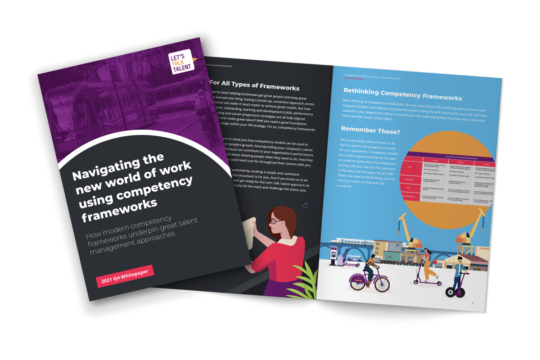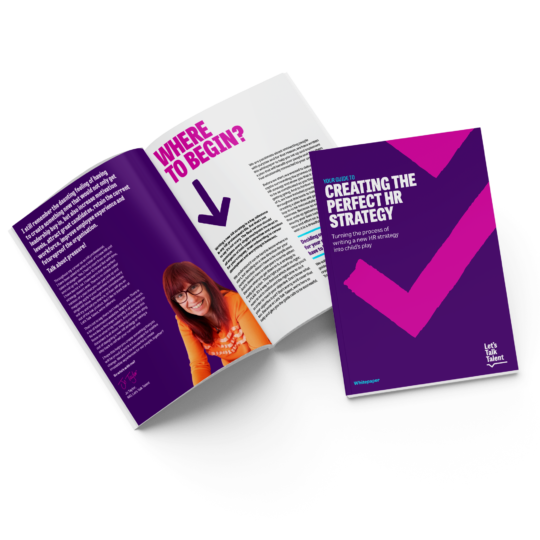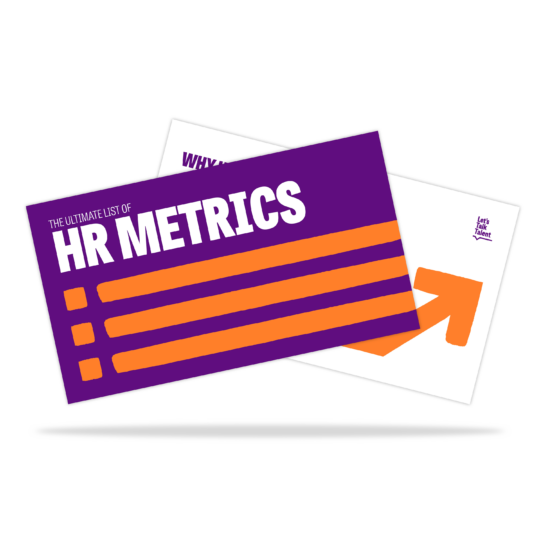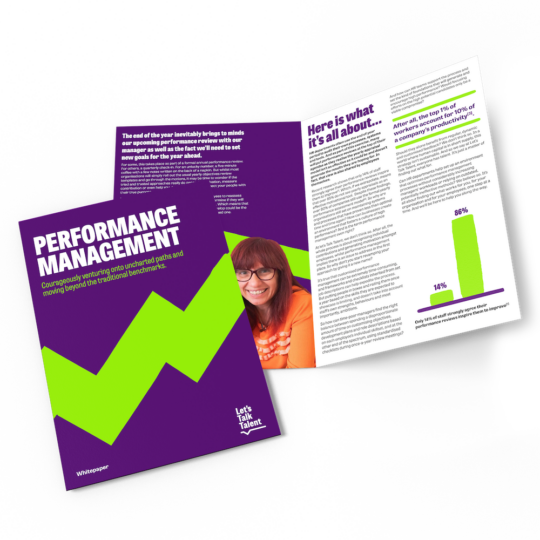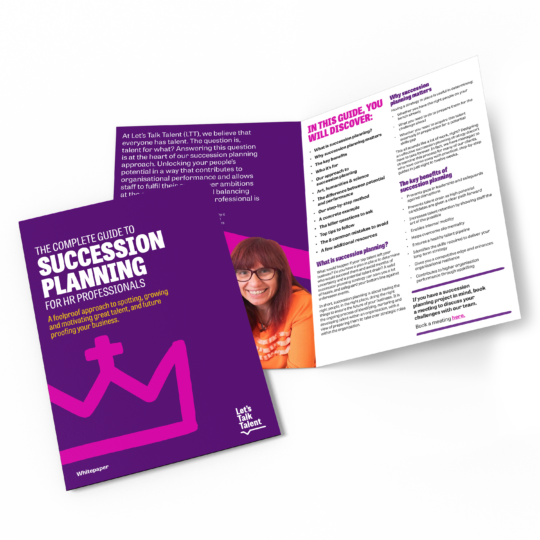The Big HR Glossary: HR Definitions & Jargon Buster
The key HR terms and definitions every people management professional needs to know to get, keep and grow brilliant people
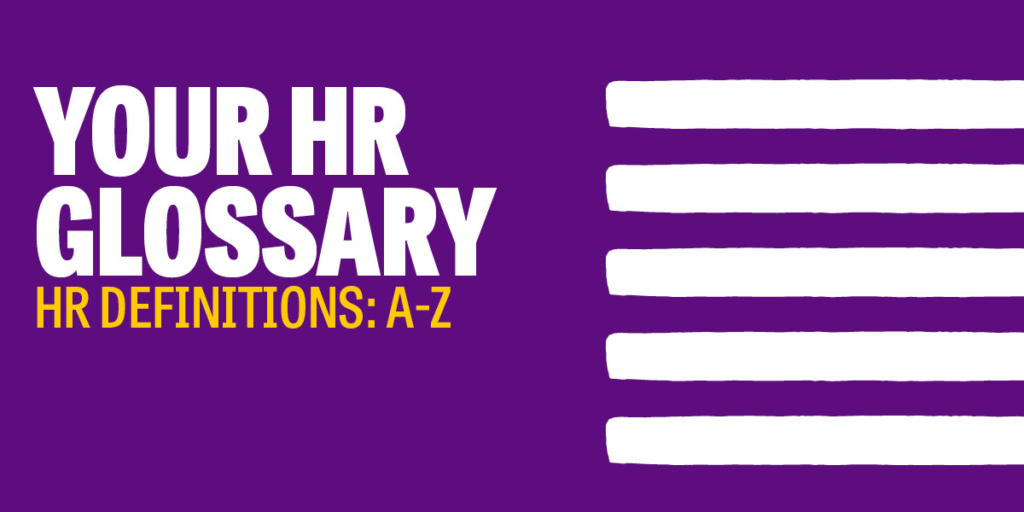
HR Glossary to help you keep HR simple – avoiding jargon
At Let’s Talk Talent, we like to keep things simple. While all HR professionals have the same goal of retaining, attracting and growing great people, the terms used to do so often vary from one business to the next. Promotion, career progression, career pathways, career development… Are they all the same? Do they cover the same ground?
That’s why we’ve created this comprehensive, plain language, no bullsh*t HR glossary of the most commonly used terms in the HR industry: to help us all speak the same language. Whether you are looking to pick the right framework to use to increase staff performance, or whether you are just starting in the industry and want to deepen your knowledge, you’ll find everything you need right here.
We hope you find this HR glossary useful. Should you want to discuss how to implement any of the initiatives below, just book a call with us. We’d love to talk.
Jo Taylor, MD & Founder at Let’s Talk Talent
About Let’s Talk Talent
First off, a little about us, in case you weren’t sure, you need a reminder, or you just want to know how to recommend us to a friend.
We are Let’s Talk Talent. A strategic talent management and organisational development consultancy based in the UK.
We help you unlock the potential of your people.
We help our clients get, keep, and grow great people.
Bonus materials
At Let’s Talk Talent, we’re always creating new resources for HR professionals. Feel free to share these with your colleagues. We hope they are useful to you and your team.
Your HR Glossary – and Jargon-Buster
0-9 – HR Definitions
A – HR Definitions
Active Learning
Focuses on a dynamic and participatory approach to learning. Active learning activates the learner’s curiosity, critical thinking, and creativity, fostering a more interactive and impactful learning experience.
Active Listening
The act of listening without thinking about what you want to say next. Listening while trying to really hear what someone is sharing.
B – HR Definitions
Behavioural Framework
Observable and measurable behaviours that contribute to successful job performance.
Blended Learning
The combination of various learning modalities, such as in-person sessions, online courses, and on-the-job training, to create a comprehensive learning experience.
Buddy
The process of assigning a peer or buddy to help new hires navigate their workplace, to answer their questions, and to provide support as needed.
C – HR Definitions
Capability Framework
A model specifically linked to the skills a business needs to grow in a particular area (such as finance or marketing, for example).
Career Development Framework
Models outlining the competencies required for career progression within an organisation and providing guidance on skill development.
Change Management
Measures taken to lead and manage organisational change, thus ensuring smooth transitions and adaptation.
Chemistry Session
This is where a coach and coachee meet to assess whether they can work together effectively. A coaching relationship requires a strong rapport and for everyone to feel they can speak freely. Put simply, a chemistry session allows both participants to check if the fit is there before proceeding.
Coaching Triad
Typically refers to a coaching model or arrangement involving three individuals: a coach, coachee and an interested stakeholder (such as a line manager). This collaborative structure is designed to facilitate a dynamic conversation and to explore the role of each person in the coaching relationship.
Collaboration
The process of working together to achieve common goals, often involving shared responsibilities and tasks.
Compensation and Benefits
The total reward system offered to employees, including salary, bonuses, and staff benefits. Often referred to as total reward.
Competency-Based Learning
A focus on the development of specific skills or competencies, rather than completion of a predetermined learning curriculum.
Competency Framework
A document that identifies the skills, training, attributes and relationships which will enhance the performance of a business and that of its people.
Competency Mapping
The process of identifying the competencies required at various levels of an organisation, and of aligning them to each role.
Continuous Feedback
Regular, ongoing communication between managers and employees aimed at discussing performance, addressing concerns, and providing guidance and support.
Continuous Learning
The concept that learning is an ongoing process, not limited to formal training, but integrated into daily work in order to foster continuous improvement.
Continuous Onboarding
An ongoing process that extends beyond the initial onboarding period and focused on continuous learning and integration. Often referred to also as the 30-day plan.
Core Competencies
Fundamental skills and behaviours that are essential for success across various roles within an organisation.
Corporate Social Responsibility (CSR)
An organisation’s commitment to ethical, sustainable and socially responsible practices.
Culture Fit
The alignment between an individual’s values, work style, and personality, and the organisation’s culture.
Cultural Transformation
Initiatives aimed at intentionally changing and evolving the existing culture of an organisation.
Customer Value Proposition (CVP)
A list of benefits a company offers its customers. This should be a short, concise statement summarising why a customer should buy a product or service.
D – HR Definitions
Diversity and Inclusion
E – HR Definitions
ED&I
The abbreviated term for Equality, Diversity and Inclusion. This relates to the efforts made by organisations to ensure all employees are treated fairly and feel they can be themselves at work.
Emergency Successor
A contingency plan for unexpected departures of key employees, often in critical positions, to ensure business continuity.
Emotional Intelligence (EQ)
The ability to understand and manage one’s emotions and navigate social interactions effectively. A crucial aspect of effective leadership.
Employee Advocacy
The promotion of an organisation by its employees, with the latter acting as brand ambassadors.
Employee Assistance Programme (EAP)
An EAP is an initiative aimed at providing support services to employees fac personal and professional challenges
Employee Engagement
The emotional commitment employees have to their work, team, and organisation.
Employee Handbook
A document that outlines important information for new hires, such as company policies, job expectations and procedures.
Employee Relations
Employee relations concern the management and maintenance of positive relationships between employees and the organisation.
Employee Surveys
The collection of feedback from employees in order to understand their needs, preferences, and satisfaction levels.
Employee Value Proposition (EVP)
EVP is the contract between an employee and the organisation. It highlights what it means to work for a business, what is required, and what people should expect in return. An EVP should be a true reflection of life when working for you, warts and all.
F – HR Definitions
Feedback culture
The creation of an environment where feedback is actively sought and provided, promoting continuous learning and development.
G – HR Definitions
Gap Analysis
The method of assessing the difference between an individual’s or a team’s current competencies and the competencies required for a role or project.
Great place to work
An award run by the Times Newspaper, and now a phrase commonly used when referring to how businesses can foster a better workplace culture for everyone.
Growth Mindset
The belief that abilities and intelligence can be developed through dedication and hard work, thus fostering a positive attitude towards learning and improvement.
H – HR Definitions
High Potential Identification
Initiatives aimed at identifying individuals who may have the ability and potential to excel in leadership positions.
Human Capital
The skills, knowledge, and abilities possessed by employees and which contribute to an organisation’s success.
HR Metrics
The Key Performance Indicators (KPIs) used to measure and analyse HR-related data.
HR Strategy
A plan detailing how to bring together a business and its people. This should fit on a page, and show employees what they need to do and how they can be successful.
HRIS (Human Resources Information System)
A software system used to streamline HR processes and store employee information.
I – HR Definitions
Inclusivity
The fact of creating an environment that welcomes and values diversity, ensuring all employees feel respected and included.
Internal Mobility
Initiatives designed to encourage and facilitate the movement of employees across different roles and departments within the organisation.
J – HR Definitions
Job Analysis
The systematic examination and documentation of the requirements, responsibilities and tasks related to a specific job.
K – HR Definitions
Key Performance Indicators (KPI)
Used to measure and benchmark performance across an organisation, whether that’s through individual performance markers, or other organisational metrics such as staff turnover rates or employee engagement.
Knowledge Sharing
The exchange of knowledge and expertise among employees to enhance collective learning and organisational knowledge.
L – HR Definitions
Learning Agility
The ability to learn quickly, adapt to new situations, and apply knowledge effectively in different contexts.
Learning Analytics
The measurement, collection and analysis of learning data to inform decision-making on an organisation’s learning and development activities.
Learning Culture
An organisational culture that values and promotes continuous learning, innovation, and skill development.
Learning Management System (LMS)
A software application for the administration, documentation, tracking, reporting, and delivery of educational courses or training programmes.
Learning Pathway
A structured sequence of learning activities designed to guide individuals through the development of specific skills or competencies.
M – HR Definitions
Microlearning
An engaging training methodology that delivers content in small, focused segments to facilitate quick comprehension and retention. Often done using short videos or interactive modules.
N – HR Definitions
O – HR Definitions
Objectives and Key Results (OKRs)
The Objectives and Key Results model is a goal-setting and leadership tool that aligns an individual’s objectives with those of the organisation.
On-the-Job Training (OJT)
Learning that occurs through hands-on experience and direct involvement in tasks relevant to the person’s role.
Organisational Design
Organisational design describes the process of aligning the structure of a business or organisation to its strategic objectives.
Organisational Development
Organisation development brings together the skills and behaviours a business needs to build and nurture in its people at all levels of the business.
P – HR Definitions
Peer Learning
Peer learning leverages the knowledge and experience of colleagues for collaborative learning, often through mentoring or peer-to-peer interactions.
People Plan
Another term for HR Strategy (see above). A people plan is less strategic, and more operational.
Performance Calibration
Sessions during which managers discuss and align their evaluations of each employee’s performance to ensure consistency and fairness across the board.
Performance Improvement Plan (PIP)
A structured plan designed to help employees overcome performance deficiencies and meet expected standards.
Performance Management
The continuous process of setting expectations, assessing progress, and providing feedback to improve individual and organisational performance.
Performance Review
The formal assessment of an employee’s job performance, often conducted through a structured review process.
Potential
The analysis of the depth and breadth of an individuals’ potential to advance within the organisation.
Psychological Safety
A work environment where team members feel safe to take risks, share ideas, and express themselves without fear of judgement or blame.
Q – HR Definitions
R – HR Definitions
Readiness
The assessment of an employee’s preparedness and suitability for advancement to a higher-level role.
Reskilling
The process of equipping employees with entirely new skills to adapt to changes in their roles or industry.
Retention
Initiatives and programs designed to retain talented employees and reduce turnover.
Reverse Mentoring
A mentoring relationship where a less experienced employee provides mentorship to a more experienced colleague, often to share insights on new technologies or perspectives.
Reward Package
S – HR Definitions
Self-Assessment
A process where employees reflect on their own competencies, strengths, and areas for improvement.
Strategic Thinking
The ability to think strategically and to align management actions with organisational goals.
Succession Planning
A term used to describe the process of spotting and preparing high-potential employees for critical (often leadership) roles within the organisation for the future.
Success Profiles
Comprehensive descriptions of the competencies and behaviours exhibited by high-performing individuals in a specific role.
T – HR Definitions
Talent Communities
Talent Development
A holistic approach that encompasses training, career development, and other initiatives to unlock employees’ potential.
Talent Management
Put simply, the process of attracting, developing, and retaining skilled individuals to meet an organisation’s strategic goals.
Talent Mapping
The identification and tracking of potential candidates with specific skills and qualifications for future roles.
Talent Pipeline
Often also referred to as talent pools or talent communities. A term used to describe potential candidates who are being considered for future job openings within the organisation.
Talent Pools
Team Charter
A document outlining the team’s purpose, goals and roles. Also often referred to as “ways of working”.
Team Cohesion
The degree of unity and connection among team members, which ultimately contributes to a positive team environment.
Team Days
Activities and interventions designed to enhance collaboration, trust, and communication within a team, often held offsite.
Team Dynamics
The interaction and level of collaboration between team members. This encompasses team communications, roles, and relationships.
Team Effectiveness
A team’s ability to achieve its goals efficiently and cohesively.
Technical Competencies
Specific skills and knowledge related to the technical aspects of a job or industry.
U – HR Definitions
Upskilling
Training and development opportunities that enhance existing skills or help employees acquire new ones, especially in response to changing job requirements.
V – HR Definitions
Values Framework
Values frameworks bring a business’s values to life. They highlight how employees are expected to act in an organisation, and are the guide rails showing what it means to work for the business.
W – HR Definitions
Workforce Planning
Workplace planning is about aligning workforce capabilities with the organisation’s long-term goals. It covers succession planning.
X – HR Definitions
Y – HR Definitions
Z – HR Definitions
Are there any terms we forgot to include in this HR glossary? Did any of the definitions above make you want to take your organisational performance to the next level? If so, don’t hesitate to book a call with us.
Alternatively, download our HR strategy whitepaper for extra tips on how to amplify your HR efforts.
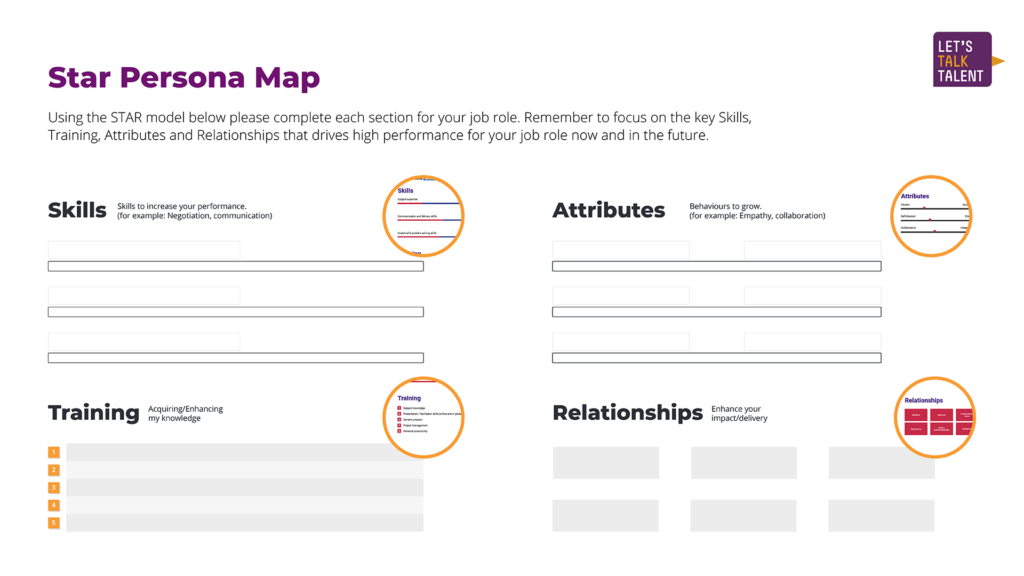
Download our blank STAR map template
Map out the skills, training, attributes, and relationships you will need in order to reach your 2023 objectives.

